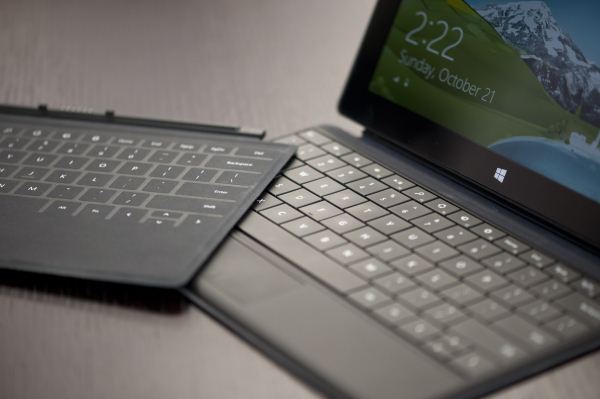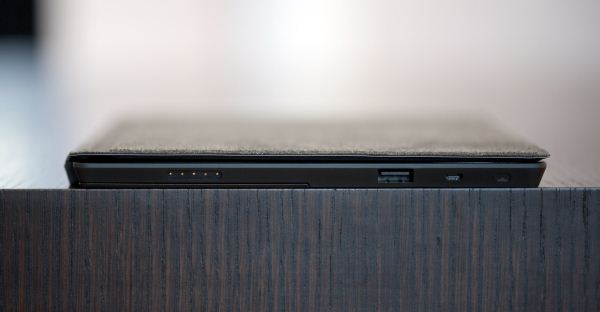Microsoft Surface Review
by Anand Lal Shimpi on October 23, 2012 9:01 PM EST- Posted in
- Tablets
- Microsoft
- Mobile
- Surface
- Windows RT
Type Cover
If Microsoft’s Touch Cover is the perfect companion for occasional typing, its Type Cover is the professional counterpart. Thickness increases by roughly 2.2mm, enough to be noticeable while still maintaining the svelte profile of Surface, but in exchange for marginally more bulk you get a keyboard with actuating scissor keys.
The keys themselves are a little bigger than in Touch Cover, thus reducing the amount of empty space between each key, but overall the feel is very similar. Where Type Cover really delivers is in its use of scissor keys. If you want more of a notebook feel, this is the way to go.
Typing quickly on Type Cover isn’t fatiguing at all and it’s just as easy to write large documents or emails using it as it would be on a traditional notebook. There are very few tradeoffs that you make to enjoy Type Cover. There’s only one color (black), and of course there is some additional thickness. The keyboard itself isn’t perfect but it’s good enough to write this review on.
I actually wasn’t bothered by the relatively shallow keystroke depth on Type Cover, although I am very used to the relatively shallow feel of most ultraportable keyboards by now. If you’re expecting the same sort of keyboard as you’d find on a thick mainstream notebook, you will be disappointed.
Type Cover’s trackpad is marginally better than what you get with Touch Cover. The trackpad is actually a tiny, top-hinged clickpad, which makes clicking a bit easier. Tap to click and two finger scrolling are both supported. The trackpad surface isn’t particularly smooth, and it isn’t all that large of a surface which work together to make scrolling nice and frustrating. The lower right section of the trackpad serves as a physical right mouse button.
Type Cover sells at a $10 premium to Touch Cover. At $129 it isn’t cheap, but it’s likely the option anyone who is going to do a lot of typing will need to take to get the most out of their Surface RT tablet.
My only complaint with Type Cover was that it would randomly stop accepting keystrokes in mid sentence, sometimes even in the middle of a word. I’m not entirely sure what’s going on, whether I’m hitting performance limitations and the platform is just dropping keystrokes or if there’s a physical problem with my unit (or Type Cover in general), but it was annoying. Even with the occasional dropped keystrokes I was still able to type faster and better on Type Cover than I could with Touch Cover. If you write for a living, you can live with Touch Cover, but you’d probably rather have Type Cover. Neither is as good as a traditional notebook keyboard, but both are light years ahead of typing on a glass screen.
















235 Comments
View All Comments
Krysto - Wednesday, October 24, 2012 - link
So their (real) excuse for using a lower resolution is that they didn't use a more powerful chip? Ok, but the problem remains that they're using a chip that can go in $200 tablets as well, a lower resolution display, and also a much smaller battery than the iPad, and yet it still costs $500.The extra storage is irrelevant, since they need that for cover for the greater size of Windows and Office, and they shouldn't make the user pay for it. Also how do they explain the fact that Google will use a much more powerful chip (Exynos 5 Dual) and a much higher resolution (2560x1600) in their upcoming Nexus 10 tablet, and yet will still cost $500 or less?
phexac - Wednesday, October 24, 2012 - link
Yeah the more comments like this I read, the more I realize that I was too generous in my post below. Surface seems destined to be a crap release and Anand did a terrible job at presenting an honest review of it.shompa - Wednesday, October 24, 2012 - link
Is WindowsRT sandboxed?If the OS is sandboxed: how do apps access the microSD slot?
I have seen many Windows Phone/Androids that have to reformat the system and reinstall everything to get the apps to "see" the microSD.
Can you install apps to the microSD?
scorpian007 - Wednesday, October 24, 2012 - link
You can't install apps to the microSD card, it's only for media (photos, videos, music).phexac - Wednesday, October 24, 2012 - link
This really seems to me like a tablety take on the netbook, and those turned out to be underpowered pieces of crap. MS looks to be going down the same road with an OS that tries to be like a desktop OS, but that can't really run all the OS programs. When it tries to run Office, it starts choking.We have no retina display.
App launch times are horrid for a tablet.
I really don't see the point of this device. If I am going to type or actually produce something, I am going to do iton my macbook air. If I want a tablet, I really don't care about a crappy attachable keyboard for $130+. If you say well I want a cheap laptop, well then you are back to the netbook argument, except the Surface is 2x or more the price, in the same price range as most fully-featured laptops, except it actually doesn't even have a fully functional desktop OS. This is a device typical of Microsoft, which never seems to think about how people will use the device and what they will want to use it for. They come up with a device that tries to straddle the fence on everything, and as a result ends up doing everything shitty (and with a shit screen, given the retina display and other displays following it being out there). Reading this review leads me to see complete and utter failure for MS in this device. And this is the reason they are making Windows 8 into an abomination? Pretty sad honestly, though not really unexpected.
N4g4rok - Wednesday, October 24, 2012 - link
"App launch times are horrid for a tablet."There weren't any numbers relating to App launch time. He made a statement about them being a little longer than he expected. How does that equate to 'horrid'?
andrewaggb - Wednesday, October 24, 2012 - link
he also said switching once they are 'open' is really fast, so this might be ok.TheBasicMind - Wednesday, October 24, 2012 - link
I think Microsoft really have something. Though I did wince reading you tried to adjust trackpad scrolling by resorting to the registry. I see the registry and access to it as part of a MS mindset that is not about openness or any positive philosophy (like LINUX), but instead about fear of having missed something. It opens up an untestable number of configurations a world of potential system problems and pain. I've not missed it in any way shape or form since moving my computing away from MS. And it is part if a computing past I have actively and willingly left behind. This is the company where still in Word, after several generations of releases, if you leave the document map open while editing cross references, you are guaranteed to have a badly corrupt document within 2 hours of working on it (GUARANTEED). How many combined years of user pain does that represent?.The only explanation for this fundamental lack of quality control is that it became like a messy room, which when mess was left long enough, just became a part of the background (I did abandon after Vista and have heard from many sources Windows 7 was a big improvement). I know other OS's have their problems (though in my experience, nothing like MS's offerings) I'm sure Surface is different (it has to be for the sake of MS). I think it may well hit the right spots for me. However over the years, the MS brand has become a kind if giant anti-brand for me and MS have to overcome that as well. They have a very high mountain to climb. So for me it will be surface 2, if and only if Surface 1 is a roaring success.Jxpto - Wednesday, October 24, 2012 - link
"Switching between applications is faster on Surface/Windows RT than any competing mobile platform. There’s no double tapping of anything, no pressing and holding, just an edge gesture swipe like you’re flipping through pages of a virtual book".That's not accurate at all... You don't even need to move your hand to the edge to switch between apps in the iPad. It's just a 4 finger gesture... And also just a four finger gesture to bring the task switcher... Or a not her gesture to go to the home screen. So in what is the Surface better regarding this??
turnipmaster - Wednesday, October 24, 2012 - link
Firstly, out of 32GB, the OS require at least 10GB+, so we know that this is no lightweight solution.The load times seem outrageous, my trusty Lumia 710, after a reboot, loads the Nokia maps app in ~2 seconds, this on an old Arm A8 based SoC. My Nexus 7, has the same Tegra 3 as the Surface as is damn sight faster at opening apps.
The wisdom of a psuedo facsimile of Windows 8, that can't run legacy / x86 apps yet obviously brings additional performance demands over a mobile focused OS, like WP8 is lost on me. If MS knew this, why didn't it chose a higher spec SoC, they haven't even used the fastest Tegra 3, the T33 would have been a nice boost over a regular Tegra 3.
I personally think WP8 could have been tweaked to be awesome on the surface, but Microsoft intended to use it to push their weird vision of Windows 8 RT. It is a shame that performance detracts from a cool device with a lot of potential, especially as Apple has blind-sided them, with a big boost to the iPad's performance with the A6X.